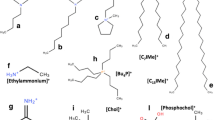Abstract
-
Aims and Background. Ionic liquid application in industry will offer several excellent solutions, but it also means that they will enter the environment sooner or later. Responsible product design should always take into consideration not only technological demands, but also the risks arising out of possible toxicity and ecotoxicity. In our strategy we are aiming to understand the fate of these entities through their life cycle in the environment as a complimentary element of their design. This paper presents results on the lipophilicity of selected imidazolium ionic liquids, a parameter that plays a key role in environmental and biological distribution. Additionally, the prediction of the most stable metabolite of a 1-butyl-3-methylimidazolium (BMIM) cation – a congener representative of this group of compounds is presented.
Materials and Methods
Lipophilicity was evaluated by means of reversed phase and immobilized artificial membrane chromatography and further compared to calculated data. Theoretical prediction of lipophilicity was undertaken using fragmental methodology combined with manual calculations of the geometric bond factor for quaternary ammonium and the electronic bond factor due to the presence of a charge.
Results and Discussion
All the substances studied are characterized by very low partition coefficients, and lipophilicity varies linearly with elongation of the n-alkyl chain. Prediction of metabolic routes was based solely on thermodynamic data of the radical intermediates formed during the reaction with the cytochrome P450 system. The energetically most stable radical structure is generated by hydrogen abstraction from the gamma position of the BMIM cation.
Conclusions
and Recommendations. The experimentally measured and theoretically estimated lipophilicity coefficients obtained for all the compounds studied generally indicate a relatively low lipophilicity and thus preferable partition to the aqueous phase. By means of thermodynamic data, it was also confirmed that the energetically most stable radical structure is generated by hydrogen abstraction from the gamma position on the alkyl chain in the 1-alkyl-3-methylimidazolium cation, as a result of which the C1 atom is preferentially oxidized.
-
* The basis of this peer-reviewed paper is a presentation at the 9th FECS Conference on 'Chemistry and Environment', 29 August to 1 September 2004, Bordeaux, France.
Similar content being viewed by others
Author information
Authors and Affiliations
Corresponding author
Rights and permissions
About this article
Cite this article
Stepnowski, P., Storoniak, P. Lipophilicity and Metabolic Route Prediction of Imidazolium Ionic Liquids * (6 pp). Env Sci Poll Res Int 12, 199–204 (2005). https://doi.org/10.1065/espr2005.05.255
Received:
Accepted:
Published:
Issue Date:
DOI: https://doi.org/10.1065/espr2005.05.255




